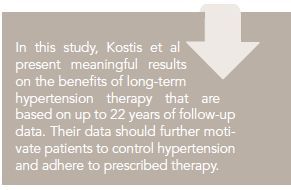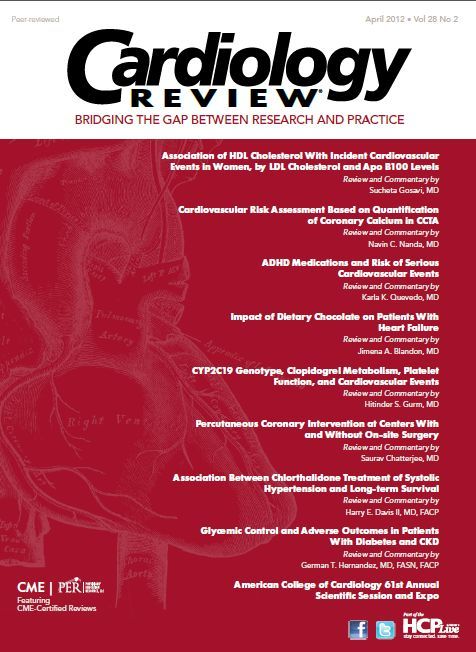Publication
Article
Association Between Chlorthalidone Treatment of Systolic Hypertension and Long-term Survival

Harry E. Davis II , MD, FACP
Review

Kostis JB, Cabrera J, Cheng JQ, et al. Association between chlorthalidone treatment ofsystolic hypertension and long-term survival. JAMA. 2011;306:2588-2593.
The original results of the Systolic Hypertension in the Elderly Program (SHEP), published in 1991,1 demonstrated a significant reduction in the incidence of stroke in persons 60 years and older with isolated systolic hypertension. The study had a multicenter, randomized, double-blind, placebo- controlled design in which 4736 persons with systolic blood pressures ranging from 160 to 219 mm Hg and diastolic blood pressures less than 90 mm Hg were enrolled. The average systolic blood pressure was 170 mm Hg and the average diastolic blood pressure 77 mm Hg. The mean age was 72 years.
Using a stepped-care approach, patients were treated with chlorthalidone 12.5 mg/d or matching placebo (step 1). Step 2 called for adding atenolol 25 mg/d (or 0.05 mg/d of reserpine if atenolol was contraindicated) or matching placebo, followed by an increase to 50 mg/d (0.1 mg/d reserpine) if needed.
With an average follow-up of 4.5 years, the 5-year incidence of total stroke was 5.2 per 100 participants for active treatment and 8.2 per 100 for placebo, producing a relative risk of 0.64 (P = .0003). The active treatment group had a relative risk of 0.73 for the secondary end point of clinical nonfatal myocardial infarction plus coronary death, 0.68 for major cardiovascular events, and 0.87 for deaths from all causes. The SHEP study concluded that in persons 60 years and older with systolic hypertension, antihypertensive stepped-care drug treatment with low-dose chlorthalidone as a step 1 medication reduced the incidence of total stroke by 36%, with a 5-year absolute benefit of 30 events per 1000 participants. Major cardiovascular events were also reduced, with a 5-year absolute benefit of 55 events per 1000.
At the end of the study, all participants were advised to receive active therapy.
Study Details
To examine the possibility of a legacy effect, 2 Kostis et al obtained long-term follow- up for mortality and cause of death by matching personal identifiers of the participants to the National Death Index for deaths through December 31, 2006.The time interval between the beginning of recruitment and the ascertainment of death was approximately 22 years. Longterm follow-up data were analyzed to estimate the net gain in life expectancy free from cardiovascular death in the active therapy group by determining the mean number of days that survival in the treatment group exceeded that of the placebo group. The difference in median survival free from cardiovascular death between the active therapy and placebo groups was also evaluated. An adjustment in this analysis was required to analyze the 70th percentile based on the relatively limited number of cardiovascular deaths in the participants. The results of this analysis indicated a survival free of cardiovascular death at 22 years of 516 days for the active treatment group. This translates to a gain in life expectancy free from cardiovascular death of 1 day per month of treatment. For all-cause mortality, the gain in life expectancy of 205 days translated to a gain of one-half day per month of antihypertensive drug treatment.
References
1. SHEP Cooperative Research Group. Prevention of stroke by antihypertensive drug treatment in older persons with isolated systolic hypertension: final results of the Systolic Hypertension in the Elderly Program (SHEP). JAMA. 1991;265:3255-3264.
2. Chalmers J, Cooper ME. UKPDS and the legacy effect. N Engl J Med. 2008;359:1618- 1620.
3. Moser M, Feig PU. Fifty years of thiazide diuretic therapy for hypertension. Arch Intern Med. 2009;169:1851-1856.
4. Ernst ME, Moser M. Use of diuretics in patients with hypertension. N Engl J Med. 2009;361:2153-2164.
5. Chobanian AV, Bakris GL, Black HR, el al. The Seventh Report of the Joint National Committee on Prevention, Detection, Evaluation, and Treatment of High Blood Pressure: the JNC 7 report. JAMA. 2003;289:2560-2572.
6. Carter BL, Ernst ME, Cohen JD. Hydrochlorothiazide versus chlorthalidone: evidence supporting their interchangeability. Hypertension. 2004;43:4-9.
7. Kaplan NM. The choice of thiazide diuretics: why chlorthalidone may replace hydrochlorothiazide (editorial). Hypertension. 2009;54:951-953.
8. Beckett NS, Peters R, Fletcher AE, et al. Treatment of hypertension in patients 80 years of age or older. N Engl J Med. 2008;358: 1887-1898.
COMMENTARY
Chlorthalidone Therapy in Systolic Hypertension
Kostis et al have provided welcome information about the long-term, meaningful results of hypertension therapy. Evaluations of the effectiveness of hypertension
treatment have shown a tendency for improved cardiovascular outcomes with the lowering of blood pressure. 3,4 However, this analysis, based on post-trial monitoring
of cardiovascular and mortality outcomes with up to 22 years of follow-up data, provides convincing support for the control of hypertension. As the authors suggest, the association of 1 day prolongation of life expectancy free from cardiovascular death for each month of antihypertensive therapy may provide excellent motivation for patients to adhere to their prescribed therapy.
Admittedly, it would be desirable to analyze the actual post-study therapy in each group to determine if significant differences existed in the post-study management of these patients. However, the assumption that the actual antihypertensive therapy, along with management of lipids, diabetes, and other risk factors, was likely comparable seems reasonable. To the degree that the significant and sophisticated analysis by Kostis et al is valid, their conclusion that the patients in the intervention group of the SHEP trial who were treated with a chlorthalidone-based stepped-care therapy for 4.5 years had a significantly lower mortality after 22 years of follow-up seems very reasonable.
A significant contribution of this study is the support it lends to the recommendation from the Seventh Report of the Joint National Committee on Prevention, Detection,
Evaluation, and Treatment of High Blood Pressure (JNC 7) for the use of thiazide diuretics for most patients with hypertension.5 A second and related contribution is the
support of the use of chlorthalidone as a diuretic of choice. The tendency for selecting hydrochlorothiazide (HCTZ) as the diuretic of choice in the United States has been discussed in several reviews,6,7 all of which note the evidence in favor of chlorthalidone as a more effective choice over HCTZ. It is indeed an interesting and perhaps somewhat puzzling observation that, despite being the most commonly prescribed antihypertensive drug in the United States, HCTZ lacks evidence that in its usual dosage of 12.5-25 mg/d a significant reduction in myocardial infarction, stroke, or death is to be gained. However, pending a head-to-head trial comparing these 2 diuretics, the current evidence supports a preference for chlorthalidone over HCTZ, especially when used as single-drug therapy.
A final note with regard to the choice of diuretic therapy for the treatment of hypertension is the use of indapamide as initial therapy, as was done in the Hypertension
in the Very Elderly Trial (HYVET) in patients over 80 years of age.8 In this double-blind, randomized, placebocontrolled clinical study conducted in Europe, Russia, and Tunisia, active therapy began with indapamide (1.5 mg, sustained release) with the subsequent addition of the angiotensin-converting-enzyme inhibitor perindopril (2
or 4 mg) as needed to achieve the target blood pressure of 150/80 mm Hg. The results showed a significant lowering of blood pressure, rate of fatal or nonfatal stroke, death from stroke, death from any cause, death from cardiovascular causes, and heart failure.
So, like most scientific studies, the results may suggest answers to our questions but tend to raise additional questions in their place. In this case, we have evidence that we may want to consider using chlorthalidone as our initial choice of antihypertensive therapy or switching our diuretic therapy from HCTZ to chlorthalidone when our patient’s blood pressure control is inadequate. We may also wish for a well-designed, blinded, randomized, and placebocontrolled study to look at a head-to-head comparison of these 3 options (HCTZ, chlorthalidone, and indapamide) to provide a more definitive basis for our choice of diuretic therapy. Unfortunately, given the generic availability of these drugs, this seems unlikely. So for now, the choice of chlorthalidone over HCTZ seems reasonable.
About the Author
Harry E. Davis II , MD, FACP, is associate professor of medicine and vice chair for education in the Department of Internal Medicine, Texas Tech University Medical Sciences Center, El Paso. Dr Davis received his medical degree from West Virginia University in Morgantown, and did his internal medicine residency at Philadelphia General Hospital in Philadelphia and Letterman Army Medical Center in San Francisco. He has practiced medicine with the US Army in many capacities, including chief of emergency medicine in Fort Lewis, Washington, division surgeon in the 1st Infantry Division, Fort Riley, Kansas, and as commander of the field hospital/chief medical officer with the UN Forces in Port-au-Prince, Haiti. Dr Davis has received numerous honors and awards for service and teaching.
